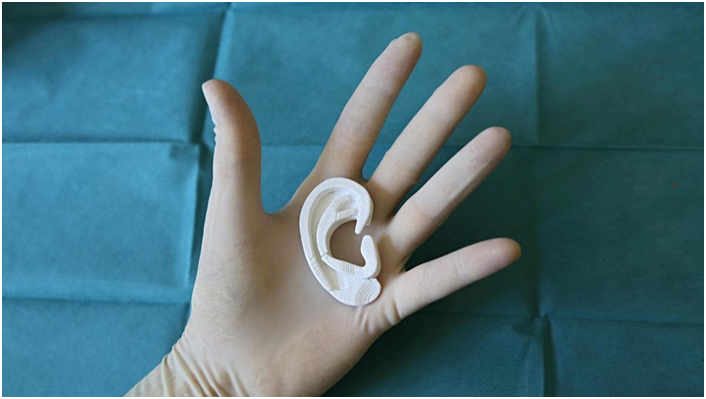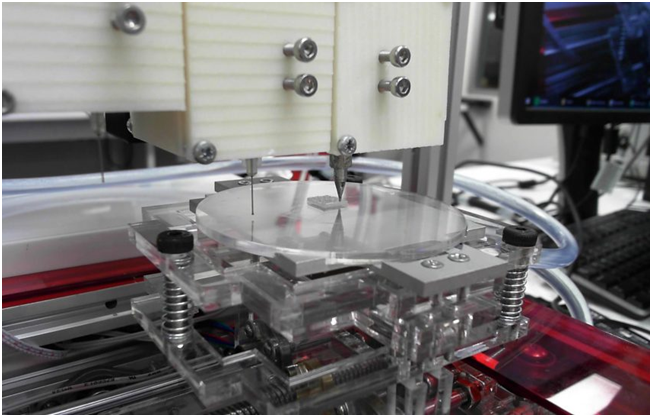
Charles Goulding Jr. takes a look at bioprinting developments targeting the complex ear.
Bioprinting Moves Forward
Last year, researchers in Israel’s Tel Aviv University’s School of Molecular Cell Biology and Biotechnology made news with a 3D printed heart. Because the ink contained biomaterial, the process itself was known as bioprinting. Using a bio-ink containing stem cells, the scientists printed layer upon layer of heart tissue.
Among other benefits, heart bioprinting obviates the need for scaffolding. Before, when a heart was made from scratch, scaffolding preserved the shape of the organ as it built up. The scaffolding could toxify over time, however, or lead to other complications as it decomposes.
The Tel Aviv University results are a major step forward, but bioprinted hearts are not ready for transplantation. They will be when the heart’s multiple layers of different tissue can all be printed together, and when the organ’s advanced functionalities, like contracting and expanding, are mastered. For similar reasons, lungs represent another bioprinting holy grail.
The Intricate Ear
The ear is another highly complex organ that has galvanized bioprinting’s attention. Broadly speaking, the ear contains three sections: 1) the outer ear, which collects sound and directs it inward; 2) the middle ear, which contains numerous tiny structures and ossicles; and 3) the inner ear, where sound processes into nerve signals.
Each intricate section has already benefited from 3D printing’s incredible capacity for customization. Tiny prosthetic parts for the middle ear, including the anvil, hammer, and stirrup, have all been 3D printed; so, too, have cochlear implants using micro-scaffolding of the necessary electrodes. In all cases, the ability to make custom parts has greatly reduced surgical invasiveness for an organ easily susceptible to further damage.
Bioprinting the Ear
Recently, 3D printing for the ear has taken yet another step forward. Now, in addition to biocompatible prosthetics, researchers have begun bioprinting the ear itself.
In one example, researchers from Australia’s University of Wollongong grew ear tissue in a lab for grafting onto a patient’s own ear. The printing machine, dubbed 3D Alex, used stem cells as bio-ink to print living tissue for reconstructive surgery.
One of the first surgeons to use the machine in a hospital, Payal Mukherjee, noted, “Treatment of this particular ear deformity is demanding because the outer ear is an extremely complex 3D shape, not only in length and breadth, but also in height and projection from the skull.”

Then, just the year, scientists in China did something astounding by 3D printing an ear directly onto a mouse. Researchers at the State Key Laboratory of Biotherapy and Cancer Center, West China Hospital, Sichuan University, built an ear layer upon layer in vivo. They did so using only 3D printed bio-ink and patterned near-infrared light.
In this technique, a digital chip contains precise building instructions for the ear. Light enters the chip and beams out in the shape of the desired object, in this case, an ear. The researchers chose near-infrared as a light precisely because once it hits living skin it has the ability to penetrate that skin to the implanted bio-ink beneath. The light activates the ink and, amazingly, guides the growth of the nascent organ into the shape of the ear as coded in the chip.
Describing the significance of the 3D printing achievement, the researchers noted, “This work provides the proof of concept for the non-invasive in vivo 3D bioprinting that would open a new avenue for medical 3D printing and advance the minimally invasive or non-invasive medicine.”
The scientists, like those in Australia, speculate their procedure may be especially useful for microtia, a condition that prevents ears from proper maturation.
The Research & Development Tax Credit
3D printing firms innovating in technologies that touch on desalination can avail themselves of the federal R&D tax credit to help subsidize their research efforts.
Enacted in 1981, the now permanent Federal Research and Development (R&D) Tax Credit allows a credit that typically ranges from 4%-7% of eligible spending for new and improved products and processes. Qualified research must meet the following four criteria:
- Must be technological in nature
- Must be a component of the taxpayer’s business
- Must represent R&D in the experimental sense and generally includes all such costs related to the development or improvement of a product or process
- Must eliminate uncertainty through a process of experimentation that considers one or more alternatives
Eligible costs include U.S. employee wages, cost of supplies consumed in the R&D process, cost of pre-production testing, U.S. contract research expenses, and certain costs associated with developing a patent.
On December 18, 2015, President Obama signed the PATH Act, making the R&D Tax Credit permanent. Beginning in 2016, the R&D credit can be used to offset Alternative Minimum Tax for companies with revenue below $50MM and for the first time, pre-profitable and pre-revenue startup businesses can obtain up to $250,000 per year in payroll tax cash rebates.
Conclusion
Bioprinting represents one of the most exciting areas of 3D printing going forward. Indeed, 3D printing has moved well beyond plastics to encompass biocompatible materials that can interact with living organisms; as well as bio-inks that can grow living tissue.
Among its many benefits, 3D printing can customize replacement parts, whether prosthetic or living tissue, reducing surgical risk. Furthermore, the Sichuan University research suggests that in some respects the world may be preparing to move beyond surgery entirely with the help of 3D printing. R&D along these exciting lines generates tax credits that can support these developments.
